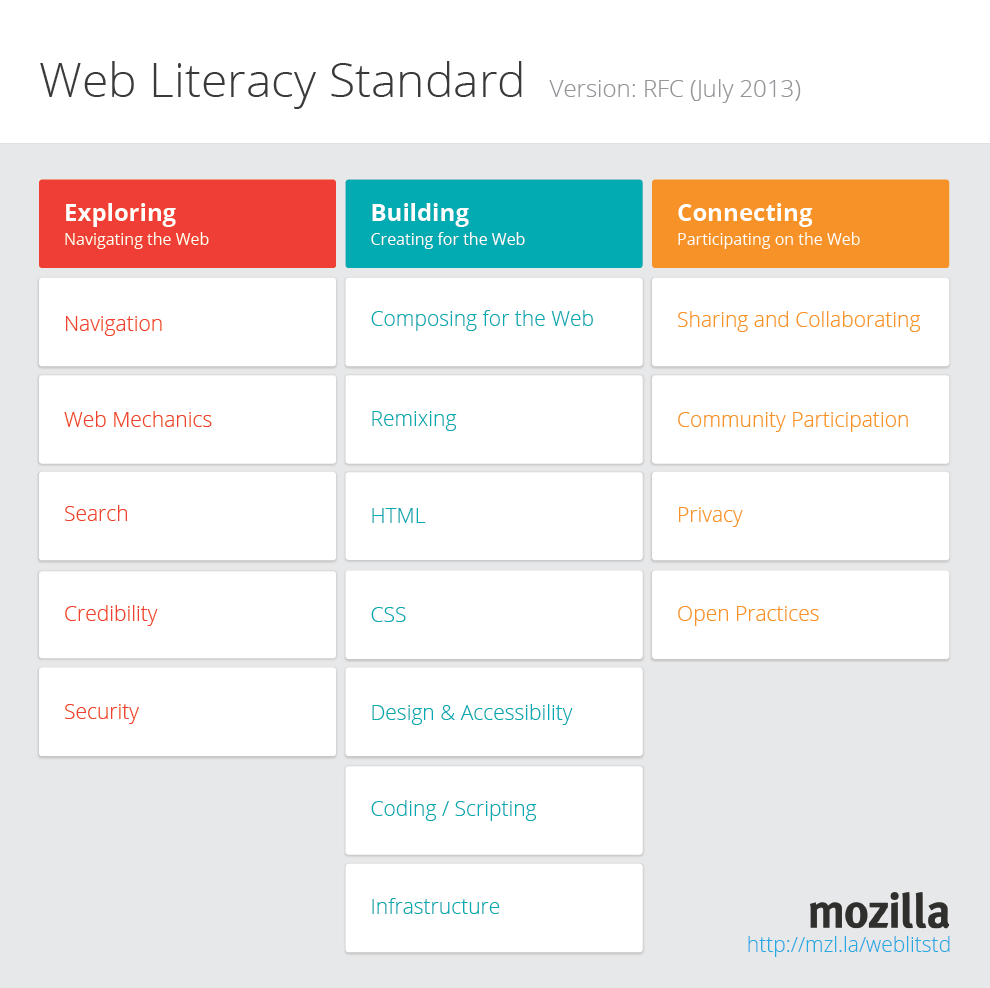Today we’re excited to announce the beta launch of a new, open learning standard for web literacy. This is part of Mozilla’s ongoing goal to create a generation of webmakers – those who can not only elegantly consume but write and participate on the web.
What is a Web Literacy Standard?
Just like how math and writing skills have standards for student and teacher performance, the Web Literacy Standard provides a map of the competencies and skills that are important to pay attention to when getting better at reading, writing and participating on the web.
Having a shared web literacy standard helps provide a framework for organizations that want to help teach new skills, and lets them align what they’re teaching with a big picture of web literacy—so that learners know how the skills they’re getting fit into the ever changing digital world.

Why a standard?
Web literacy frameworks up to this point have suffered from two problems. The first is that they have largely been extensions of digital, media and/or information literacy. The web is different from other mediums, meaning that the skills and competencies required are also different.
The second problem with existing frameworks is the great work that’s been going on has happened in silos. It hasn’t been connected together very well. The Web Literacy Standard aims to change that. We’ve brought together stakeholders from diverse backgrounds to co-create an open learning standard that anyone can align with.
Why Mozilla?
Enshrined in the Mozilla manifesto is our belief that individuals must have the ability to shape the internet and their own experiences of it – and that the effectiveness of the internet as a public resource depends upon decentralized participation worldwide. Further to this mission, the Web Literacy Standard provides a map of the skills needed to read, write and participate online.
Inside the Web Literacy Standard
In its current form, the Web Literacy Standard comprises a map of competencies and skills that Mozilla and our community of stakeholders believe are important. It doesn’t just cover coding, but a broad way of understanding and participating in the web, including competencies such as privacy, community and search.
The skills underpinning each competency are augmented with examples focused on action and production. We believe that knowledge should be accompanied by the ability to do something new. As such, the skills are all verb-based.
How did we get here?
The Web Literacy Standard began life as a framework to underpin our work around Webmaker. Since widening our scope, we’ve engaged a range of people who are involved in teaching or learning the skills and competencies we have defined. We’ve spent the last six months talking to educators, learners and interested parties, and developing the standard through community calls that were open to anyone who wanted to participate.
We are not arbiters of who is or is not “web literate.” We are instead providing a framework others can align with and build upon.
What’s next?
Since this is a beta release, we need your help to tear into the standard: test it, add to it, and make sure it’s doing what we need it to do. We’re looking for feedback from educators, mentors, policy makers and learners. If you have an opinion, then we want to hear from you! What have we missed? Can you map your work against it? What needs changing or tweaking?
We’re aiming for a v1.0 release at the Mozilla Festival in October — our annual gathering of bright minds from around the world who meet to teach and build a better web. At that point we’ll be looking for organizations large and small to align with the standard.
Get Involved
- Explore the Web Literacy Standard.
- Learn more on the wiki.
- Send us your comments. Tell us what we might be missing and how we could make this better.
- Follow our work on the Web Literacy Standard blog.
- We’re on Twitter @weblitstd